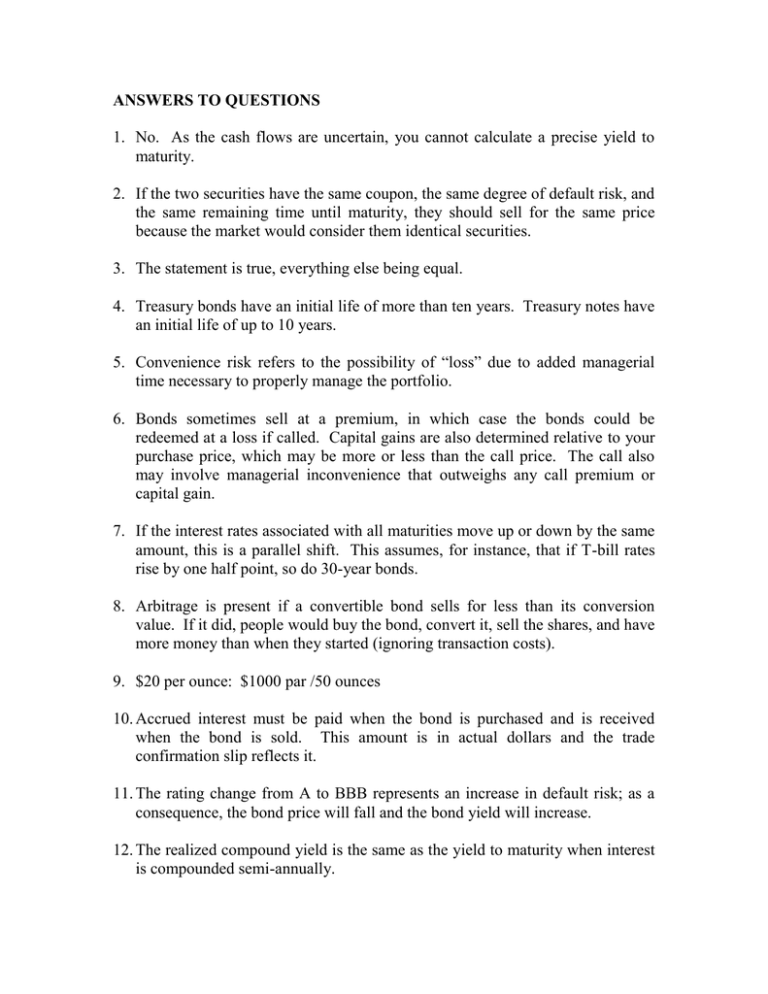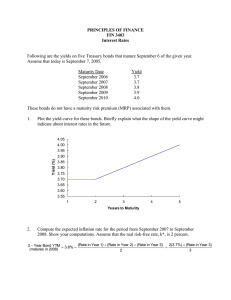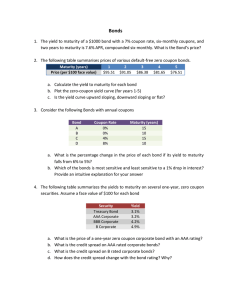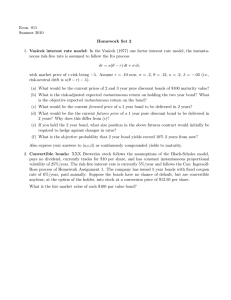ANSWERS TO QUESTIONS maturity.
advertisement

ANSWERS TO QUESTIONS 1. No. As the cash flows are uncertain, you cannot calculate a precise yield to maturity. 2. If the two securities have the same coupon, the same degree of default risk, and the same remaining time until maturity, they should sell for the same price because the market would consider them identical securities. 3. The statement is true, everything else being equal. 4. Treasury bonds have an initial life of more than ten years. Treasury notes have an initial life of up to 10 years. 5. Convenience risk refers to the possibility of “loss” due to added managerial time necessary to properly manage the portfolio. 6. Bonds sometimes sell at a premium, in which case the bonds could be redeemed at a loss if called. Capital gains are also determined relative to your purchase price, which may be more or less than the call price. The call also may involve managerial inconvenience that outweighs any call premium or capital gain. 7. If the interest rates associated with all maturities move up or down by the same amount, this is a parallel shift. This assumes, for instance, that if T-bill rates rise by one half point, so do 30-year bonds. 8. Arbitrage is present if a convertible bond sells for less than its conversion value. If it did, people would buy the bond, convert it, sell the shares, and have more money than when they started (ignoring transaction costs). 9. $20 per ounce: $1000 par /50 ounces 10. Accrued interest must be paid when the bond is purchased and is received when the bond is sold. This amount is in actual dollars and the trade confirmation slip reflects it. 11. The rating change from A to BBB represents an increase in default risk; as a consequence, the bond price will fall and the bond yield will increase. 12. The realized compound yield is the same as the yield to maturity when interest is compounded semi-annually. 13. This is because of reinvestment rate risk and because future reinvestment rates are unknown. 14. The convertible bond’s conversion value. 15. Companies issue convertible bonds largely because they hope never to have to pay them off. The firm wants the bondholder to convert, likes to see the number of shareholders grow, and is not interested in having the debt reappear on the books. This could cause a violation of other debt covenants and make short term financial planning difficult. 16. There is no way to make a riskless dollar. Buying the bond, converting it, and selling the stock would leave you with less money than when you started. ANSWERS TO PROBLEMS 1. Five year: FV PV (1 R ) 2 N = $1000 (1 + .09/2)10 = $1,552.97 2 interest = FV – PV = $1,552.97 - $1,000 = $552.97 4.5 year: FV PV (1 R ) 2 N = $1000 (1 + .095/2)9 = $1,518.40 2 interest = FV – PV = $1,518.40 - $1,000 = $518.40 $552.97 - $518.40 = $34.57 14 2. Assume semi annual interest: P0 t 1 40 1000 = $941.50 t (1 .095 ) (1 .095 )14 2 2 14 40 1000 t 14 t 1 (1 .095 ) t (1 .0915 )14 2 2 = 5.44 years 3. a. D 941.50 .0915 )15 (1 .0915 ) .0915 14 (1 2 2 1000 14 2 40 14 (.0915 ) 2 (1 .0915 )14 (1 .0915 2 ) 2 2 b. D 941.50 1.956 1.046 .641 1000(14) = 10.81 periods = 5.41 years 14 .002(1.871) (1.04575) = 40 4. N = 8 P0 = 500 FV = 1000 a. Using the rule of 72, the value doubles in 8 years: 72/8 = 9% b. PV FV (1 R ) t (1 R ) t FV PV R ( FV PV ) 1 t 1 R=2(1/8) – 1 = 9.05% Using semi-annual periods: R=2(1/16) – 1 = 4.43; 7 5. a. 800 t 1 14 b. 800 t 1 4.43 x 2 = 8.86% 80 1000 R = 12.44% t (1 R) (1 R) 7 40 1000 t (1 R ) (1 R )14 2 2 R = 12.73% 6. Using the 365 day convention, 7 ¼% .0725(1000)/365 = $0.1986 per day $0.1986 x 43 = $8.54 7. First solve for R: R = 10.74% 42 PV of annuity: 37.5 (1 .0543) t 1 t $632.75 PV of principal: 1000 $117.53 (1 .0543) 42 Interest: $632.75/$750 = 84.3% 8. You can use the DURATION file, set par=0 and N= 10000; this gives D = 17.67 9. Use equation 12-6: effective annual rate = [1 + R/x]x – 1 = [1 + .135/12]12 – 1 = 14.37% 10. conversion ratio = par value/conversion price = $1000/9.54 = 104.82 shares 9. conversion value = conversion ratio x stock price = 104.82 x $10 = $1048.20 10. Premium over conversion value = bond price – conversion value = $1100 - $1048.20 = $51.80 13 – 14. Student response 15. Smith has a compound yield of 10%; Jones has a simple yield of 10%. 16. Accrued interest paid: 5 x 39 days x 70/365 = Interest received: Accrued interest received: 5 x 31days x 70/365 = ($37.40) $175.00 29.73 $167.33 17. a. The point here is that once the short-term bond matures there is a reinvestment rate issue. You cannot calculate a portfolio yield to maturity when maturities do not coincide. b. If both bonds have the same maturity and market rates equal 10.5%. 18. Student response





